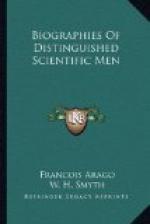The light of the head had a blueish-green tint. Was this a real tint, or did the central reddish body, only through contrast, make the surrounding vapour appear to be coloured? Herschel did not examine the question in this point of view.
The head of the comet appeared to be enveloped at a certain distance, on the side towards the sun, by a brilliant narrow zone, embracing about a semicircle, and of a yellowish colour. From the two extremities of the semicircle there arose, towards the region away from the sun, two long luminous streaks which limited the tail. Between the brilliant circular semi-ring and the head, the cometary substance seemed dark, very rare, and very diaphanous.
The luminous semi-ring always presented similar appearances in all the positions of the comet; it was not then possible to attribute to it really the annular form, the shape of Saturn’s ring, for example. Herschel sought whether a spherical demi-envelop of luminous matter, and yet diaphanous, would not lead to a natural explanation of the phenomenon. In this hypothesis, the visual rays, which on the 6th of October, 1811, made a section of the envelop, or bore almost tangentially, traversed a thickness of matter of about 399,000 kilometres, (248,000 English miles,) whilst the visual rays near the head of the comet did not meet above 80,000 kilometres (50,000 miles) of it. As the brightness must be proportional to the quantity of matter traversed, there could not fail to be an appearance around the comet, of a semi-ring five times more luminous than the central regions. This semi-ring, then, was an effect of projection, and it has revealed a circumstance to us truly remarkable in the physical constitution of comets.
The two luminous streaks that outlined the tail at its two limits, may be explained in a similar manner; the tail was not flat as it appeared to be; it had the form of a conoid, with its sides of a certain thickness. The visual lines which traversed those sides almost tangentially, evidently met much more matter than the visual lines passing across. This maximum of matter could not fail of being represented by a maximum of light.
The luminous semi-ring floated; it appeared one day to be suspended in the diaphanous atmosphere by which the head of the comet was surrounded, at a distance of 518,000 kilometres (322,000 English miles) from the nucleus.
This distance was not constant. The matter of the semi-annular envelop seemed even to be precipitated by slow degrees through the diaphanous atmosphere; finally it reached the nucleus; the earlier appearances vanished; the comet was reduced to a globular nebula.
During its period of dissolution, the ring appeared sometimes to have several branches.




